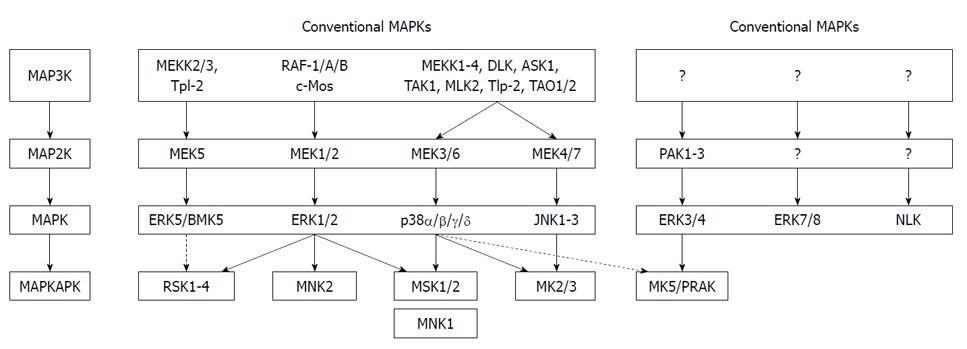Copyright
©2011 Baishideng Publishing Group Co.
World J Biol Chem. May 26, 2011; 2(5): 73-89
Published online May 26, 2011. doi: 10.4331/wjbc.v2.i5.73
Published online May 26, 2011. doi: 10.4331/wjbc.v2.i5.73
Figure 1 Mammalian mitogen-activated protein kinase pathways.
The conventional mitogen-activated protein kinase (MAPK) pathway has a tripartite composition in which MAPK kinase kinase (MAP3K) phosphorylates and activates MAPK kinase (MAP2K), which in turn phosphorylates and activates MAPK. The atypical MAPK pathway lacks this typical three-tiered cascade. Both conventional and atypical MAPKs can phosphorylate different substrates, including other protein kinases referred to as MAPK-activated protein kinases (MAPKAPKs). The stippled lines indicate that a bona fide in vivo link between these MAPKs and their MAPKAPKs remains controversial. ERK: Extracellular signal-regulated kinase; RSK: Ribosomal-S6-kinase; MNK: MAPK-interacting kinase; JNK: c-JUN N-terminal kinase; PAK: p21-activated protein kinase; MK: MAPK-activated protein kinase; NLK: Nemo-like kinase; PRAK: p38-regulated/activated protein kinase.
- Citation: Kostenko S, Dumitriu G, Lægreid KJ, Moens U. Physiological roles of mitogen-activated-protein-kinase-activated p38-regulated/activated protein kinase. World J Biol Chem 2011; 2(5): 73-89
- URL: https://www.wjgnet.com/1949-8454/full/v2/i5/73.htm
- DOI: https://dx.doi.org/10.4331/wjbc.v2.i5.73









